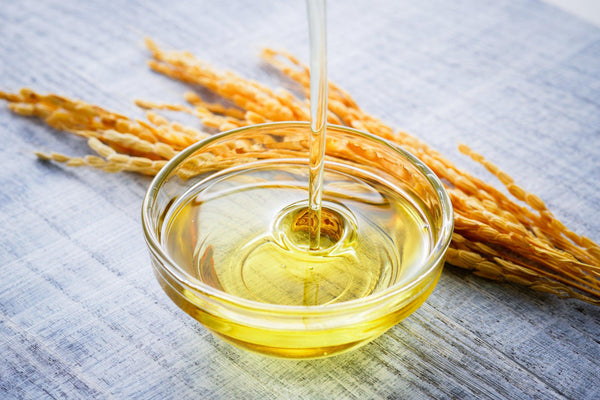Choosing The Best Oil For Frying: A Comprehensive Guide

Jump to:
Have you ever found yourself standing in the cooking oil aisle, overwhelmed by the choices and wondering which one would make your tempura perfectly crisp or your karaage irresistibly juicy?
You're not alone.
Choosing the right oil for frying can make or break your culinary creations, affecting everything from flavor to health benefits. The oil we use matters more than one might think.
Let’s oil up the gears of cooking know-how and explore the best options for frying. In this guide we will cover the smoke points, flavor profiles and health benefits of various oils. We’ll even make a special focus on a rising star in the frying world: rice bran oil.
Grab your chopsticks as we dive into the deep end of the frying pan!
Understanding Oil Smoke Points & Their Importance In Frying

Before we dive into specific oils, let's talk about a crucial concept in frying: the smoke point.
Simply put, the smoke point is the temperature at which oil starts to, well, smoke.
Why does this matter?
When oil reaches its smoke point, it starts to break down. This affects the flavor of your food (hello, bitter aftertaste!). It also leads to the formation of harmful compounds. Plus, oil that’s activated past its smoke point is more likely to catch fire.
For frying, we want an oil with a reasonably high smoke point. This lets us crank up the heat and achieve that perfect crispy exterior without worrying about that oil throwing in the towel (or throwing off smoke signals).
Here's a quick rundown of smoke points for some common cooking oils:
- Rice Bran Oil: 450°F (232°C)
- Peanut Oil: 450°F (232°C)
- Sunflower Oil: 450°F (232°C)
- Refined Olive Oil: 465°F (240°C)
- Avocado Oil: 520°F (271°C)
You may have heard, by the way, that olive oil has a low smoke point? It’s true. Olive oil is healthy when consumed at room temperature and perfectly acceptable for quick sautees and the like. But we have to be careful with olive oil when it gets too hot, as its smoke point is in the area of 350°F (175°C)
Keep in mind that these temperatures can vary slightly depending on the brand and how refined the oil is. As a general rule, more refined oils have higher smoke points, making them better suited for high-heat cooking methods like frying.
Top Oils For Frying: A Detailed Look
Now that we've cleared the air on smoke points, let's dive into our oil lineup.
Rice Bran Oil

Let's start with the dark horse of the frying world: rice bran oil.
This oil, extracted from the outer layer of rice grains, is rapidly gaining popularity among chefs and home cooks alike.
Smoke Point
At 450°F (232°C), rice bran oil can handle the heat of deep frying without breaking a sweat.
Flavor
One of rice bran oil's standout features is its neutral flavor. It won't overpower your carefully seasoned tempura or katsu, instead allowing the natural flavors of your ingredients to shine through.
Benefits
Here's where rice bran oil really takes the cake (or should we say, the tempura?). It's packed with antioxidants, including vitamin E and gamma-oryzanol, which can help lower cholesterol. It also contains compounds that may help manage blood sugar levels. Plus, its high smoke point means it's less likely to form harmful compounds during frying.
Recommended Rice Bran Oils
At Japanese Taste we have tested a number of rice bran oils on the market, and we are pleased to offer these two entries to our customers:
Tsuno Pure Japanese Rice Bran Oil Halal Neutral Cooking Oil 1000g

Tsuno Pure Japanese Rice Bran Oil, a premium halal-certified neutral cooking oil, stands out for its exceptional quality and versatility. Made from 100% rice, this oil boasts a well-balanced fatty acid composition and strong antioxidant properties, making it highly thermally stable and resistant to oxidation even when heated. Its unique flavor profile enhances the taste of any dish, resulting in a crispy finish. Whether stir-frying, deep-frying or using as a dressing ingredient, this high-quality vegetable oil elevates dishes to new heights of flavor, making it a delicious and versatile addition to any kitchen.
Tsuno Japanese Rice Bran Oil Ichiban Shibori First Pressed Oil 300g

Tsuno Japanese Rice Bran Oil Ichiban Shibori is a premium first-pressed oil extracted from domestically produced rice bran and rice germ using traditional methods dating back to the Edo period. Its mild, flavorless profile enhances the natural taste of ingredients without overpowering them. A versatile choice for various culinary applications, from dressings and mayonnaise to stir-fries and deep-frying. Favored by high-end restaurants and chefs for its exceptional quality and ability to produce a crispy finish.
Peanut Oil

A longtime favorite in many Asian cuisines, peanut oil is a solid choice for frying.
Smoke Point: Matching rice bran oil at 450°F (232°C), peanut oil is well-suited for high-heat cooking.
Flavor: It has a mild, nutty flavor that complements many dishes without overpowering them.
Benefits: Peanut oil is high in monounsaturated fats, which are considered heart-healthy. However, it's important to note that it's not suitable for those with peanut allergies.
Canola Oil

A common sight in many kitchens, canola oil is derived from a specially bred variety of rapeseed.
Smoke Point: With a smoke point of 400°F (204°C), it's suitable for most frying needs, though not as heat-resistant as some others on this list.
Flavor: Canola oil has a very neutral flavor, making it versatile for various dishes.
Benefit: It's low in saturated fat and high in monounsaturated fat, making it a heart-healthy option. However, some people prefer to avoid it due to concerns about GMOs and processing methods.
Vegetable Oil

"Vegetable oil" is often a blend of different plant-based oils, typically including soybean oil.
Smoke Point: The smoke point can vary depending on the blend but is generally around 400-450°F (204-232°C).
Flavor: It has a neutral flavor, allowing the taste of your food to come through.
Benefits: It's inexpensive and widely available. However, it's often highly processed and may contain a high proportion of omega-6 fatty acids, which some nutritionists suggest we should consume in moderation.
Sunflower Oil

Pressed from sunflower seeds, this oil is light in color and flavor.
Smoke Point: High-oleic versions can reach up to 450°F (232°C).
Flavor: It has a light, neutral taste that won't interfere with your food's flavors.
Benefits: Sunflower oil is high in vitamin E and low in saturated fats. However, like vegetable oil, it's high in omega-6 fatty acids.
Corn Oil

A popular choice for deep frying, corn oil is derived from the germ of corn.
Smoke Point: It has a relatively high smoke point of 450°F (232°C).
Flavor: Corn oil has a slightly sweet, corn-like flavor that some find pleasant for frying.
Benefits: It's high in polyunsaturated fats and contains some vitamin E. However, it's also high in omega-6 fatty acids and is often highly refined.
Safflower Oil

Extracted from the seeds of the safflower plant, this oil is less common but worth considering.
Smoke Point: High-oleic safflower oil can reach up to 510°F (266°C).
Flavor: It has a very neutral flavor, similar to sunflower oil.
Benefits: Safflower oil is low in saturated fats and high in monounsaturated fats, particularly in high-oleic varieties.
Grapeseed Oil

A byproduct of winemaking, grapeseed oil has gained popularity in recent years.
Smoke Point: It has a high smoke point of about 420°F (216°C).
Flavor: Grapeseed oil has a clean, light flavor that won't overpower your food.
Benefits: It's rich in vitamin E and contains beneficial compounds called procyanidins. However, it's also high in omega-6 fatty acids.
Avocado Oil

While pricier than some other options, avocado oil is gaining fans for its health benefits and high smoke point.
Smoke Point: With a smoke point of up to 520°F (271°C), it's one of the most heat-stable oils available.
Flavor: It has a mild, buttery flavor that works well with many dishes.
Benefits: Avocado oil is high in monounsaturated fats and contains antioxidants. It's also less refined than many other cooking oils.
Health Considerations: Which Oils Are Best For Your Well-Being?
When it comes to health, not all frying oils are created equal.
Here are some factors to consider:
- Saturated fat content: Oils high in saturated fats, like coconut oil, are generally considered less heart-healthy.
- Monounsaturated and polyunsaturated fats: These are generally considered beneficial. Oils high in these fats, like rice bran oil and avocado oil, are often recommended.
- Omega-3 to omega-6 ratio: While both are essential, many modern diets are high in omega-6 and low in omega-3. Oils with a better balance, like rice bran oil, may be preferable.
- Antioxidant content: Oils rich in antioxidants, such as rice bran oil and avocado oil, offer additional health benefits.
- Level of processing: Less refined oils often retain more nutrients.
Considering these factors, some of the healthiest oils for frying include rice bran oil, avocado oil and high-oleic versions of sunflower or safflower oil.
Choosing The Right Oil For Different Frying Methods

Deep Frying
For deep frying, you need an oil with a high smoke point that can withstand prolonged exposure to high heat. Rice bran oil, peanut oil and high-oleic sunflower or safflower oil are excellent choices.
Pan Frying
Most of the oils discussed here will work well for pan frying. Choose based on the flavor profile you're after and the specific health benefits you're seeking.
Stir Frying
For the high heat of stir frying, reach for oils with high smoke points like rice bran oil, avocado oil or peanut oil.
Not All Oils Are Created Equal: Choose Your Frying Partner Carefully
While there's no one-size-fits-all answer to the best oil for frying, rice bran oil stands out for its high smoke point, neutral flavor and impressive health benefits.
Whatever oil you choose, remember that moderation is key. Even the healthiest oil should be used judiciously as part of a balanced diet.






0 comments